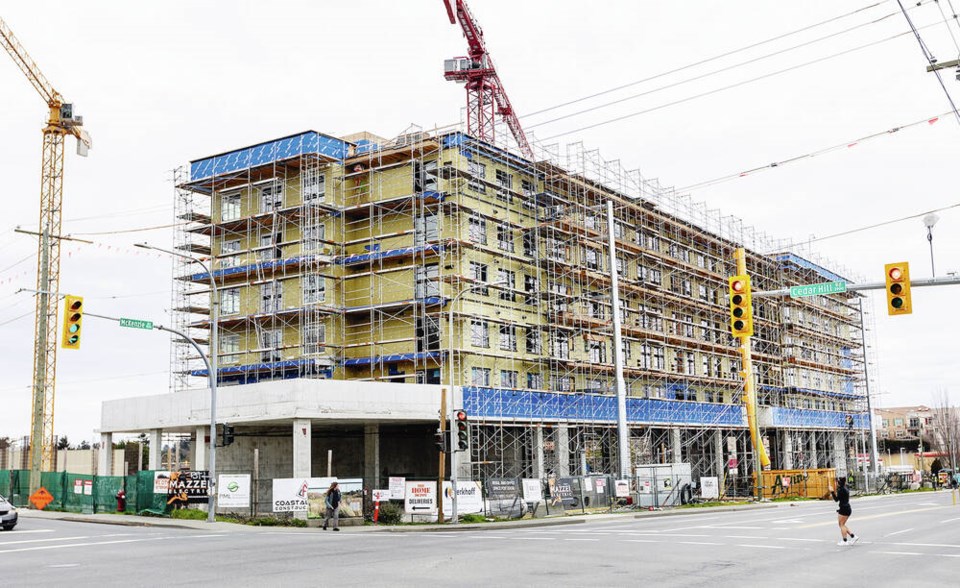Saanich will reconvene a public hearing Tuesday night to decide if its first new Official Community Plan in 16 years is ready for prime time.
Following a marathon public hearing this past week when the public were given time to weigh in on the merits of the plan, council will spend May 7 deliberating the contents of a plan that is designed to lay a foundation for growth in the district.
The public input this past week offered a broad range of opinions on the document, with some supporters appreciating the need for change, some suggesting the document was neither aggressive nor ambitious enough in tackling the need for more housing, while others raised concerns about the pace and nature of change.
Mayor Dean Murdock said much of the concern that was raised and feedback given has been heard over the past two years of public engagement.
“I think that the OCP represents change, and of course that’s going to create some uncertainty and probably fear for some folks about what that will mean in their neighbourhood,” he said. “A lot of very common themes that emerged talked about protecting the natural environment, retaining the character of neighbourhoods and preserving what we love about Saanich, and I think those are shared aspirations.”
One of the biggest sticking points raised during the public session was what happens to local area plans.
The draft OCP includes all of the local area plans and adopts them as policy, rather than forming part of the bylaw. The idea is to have the updated OCP take precedence, while still being informed by the local area plans.
While Saanich staff and council maintain the change will have a negligible effect, many residents suggested the plans were being discarded and their neighbourhoods would be vulnerable to massive change.
Murdock doesn’t see it that way, and insists district staff will still consider the guidelines in the local area plans when considering new development applications.
But the change means the OCP will be the dominant document and could override the neighbourhood plan.
For example, the updated OCP might suggest buildings can be 12 storeys in a certain area, while an outdated local area plan might have called for four-storey buildings. Under the new plan, the OCP guideline would take precedence.
Another concern raised several times this past week was a lack of consultation.
But Murdock said consultation has been ongoing over the past two years and included workshops, webinars, pop-up meetings, open houses, surveys and three rounds of consultation on the drafts.
Murdock said some of the concern could be a result of the amount of change being included in the plan.
“In 16 years there’s some catching up to do, particularly with respect to use and density,” he said. “Because of that, for some folks that change is a big jump forward and there’s concern raised about what that’s going to mean as those changes are implemented throughout the community.”
The draft Official Community Plan allows for 18-storey residential towers along some primary corridors such as McKenzie Avenue and Quadra Street, the Tillicum-Burnside area and around McKenzie Avenue and Shelbourne Street.
It incorporates new provincial legislation increasing allowable building heights around transit hubs and allowing single-family lots to be replaced by denser housing forms such as houseplexes of three to six units, townhomes or small apartment buildings.
The plan allows for building heights to increase to 12 storeys from eight in Royal Oak and to six storeys from four in Broadmead Village.
The plan will allow the district to be more flexible in its interpretation of height restrictions to accommodate more non-market rental projects or meet specific density provisions.
The draft plan incorporates the three transit-oriented development areas identified by provincial legislation — the Uptown transit hub, Royal Oak exchange and University of Victoria — that will have to align with new provincial regulations. Those regulations require building-height minimums of up to 10 storeys within 200 metres of a transit exchange and up to six within 201 to 400 metres.
Saanich added three of its own transit-oriented development areas — University Centre, Quadra-McKenzie and Tillicum-Burnside. While they are not currently subject to the provincial regulations, they would be subject to Saanich guidelines for higher-density housing.
The revised plan incorporates new demographic information and updates land-use policies to include direction on missing middle and infill housing, corridor expansion and a new emphasis on walkable neighbourhoods. Missing-middle housing is house-scale housing that includes multiple units.
The document aims to establish Saanich as a district of 15-minute communities, where households are within a 15-minute walk of key amenities such as grocery stores and other services, employment, parks and natural areas.
“We’re a growing community and the Official Community Plan is our opportunity to shape that growth so that it aligns with our vision of a healthy, vibrant and equitable community. And that means concentrating growth around centres, corridors and villages, and preserving the natural environment, trees and biodiversity in our neighbourhoods and in our rural areas,” Murdock said.



